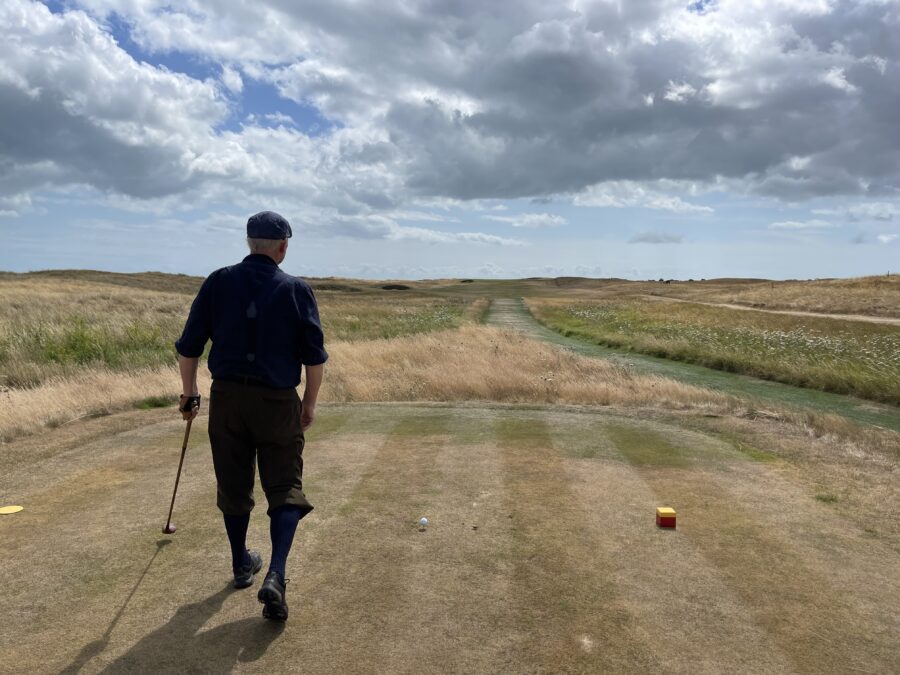As I walked into the local Barnes & Noble today, I noticed a sign on the front door, “Vinyl Records are inside.” I had been aware of the resurgent interest in vinyl recordings, but the sign on the front door of a mega-chain of bookstores made me smile.* I immediately thought to myself that all the golfers, like myself, who have embraced “hickory golf” are caught up in the same passion as those who have developed lust for vinyl in the place of CDs.
What’s the passion? It’s not hard to understand — a simple desire to return to the immediacy of a great pleasure, whether music or golf, without the “enhancements” of modern technology. Here are two instances, and I’m sure there are others, where a group of enthusiasts have come to realize the new technology had lessened the pleasure it has promised to increase.
In the case of vinyl recordings, there is no doubt in my mind, having never sold or given away my large vinyl collection, that an LP played with a decent turnable and cartridge through any kind of sound system will sound better than a CD. The sound is warmer, richer, and causes no aural fatigue. You bathe in the sound rather than being assaulted by hard edged recordings with unnecessary spotlighting of instruments and voice, usually mixed to challenge the capacities of a sub-woofer.
Vinyl recording has enabled an entire generation to experience recorded music at its best, without the prophylactic of digitalized sound. (Hey, they can even play the Beatles’ “White Album” backwards the way my college roommates did in 1968 at the University of Texas.)
Likewise, the thousands of men and women around the world who have put away their steel clubs for hickory-shafted original or reproductions (such as those of Tad Moore) of clubs from before the 1930s — the kind of clubs used by the great Bobby Jones when he won the Grand Slam in 1930. Shortly after, golfers would adopt the steel shaft, in part because of Jones’ own set of steel-shafted Spalding irons.
But by the turn of the century, advancements in club and ball technology had morphed into a preoccupation with distance — everyone began to chase after adding another twenty yards to their drives. Professional golfers began to hit the ball so far off the tee that classic golf courses like Merion, Winged Foot, and Shinnecock had to be lengthened by the addition of new tee boxes never envisioned by the course designers. Courses that once played at 650o yards were lengthened to over 7000 yards.
Watching Dustin Johnson’s monster 350 years drives at St Andrews during the last British Open made me sad — he wasn’t playing the “Old Course” anymore and, as a result, the charm, allure, and mystery of the game was being diminished. Those of us who have joined groups like the Society of Hickory Golfers, the Carolina Hickory Golf Association, and the Virginia Hickory Golf Association, have said, in effect, “Enough is enough!”**
We play our tournaments wearing plus-fours, shirts with ties, long socks, two-toned (preferably) shoes, and a cap. Vests, jackets, and other 1920s accoutrement are always welcome. Walking into a hickory golf reception and “swap meet” is just like visiting a retro vinyl shop — you meet people who are just as crazy as you are, just as enthusiastic, and ready to become friends on the spot.
Out on the course, because our tournaments are played anywhere from 5500 to 6100 yards, distance becomes relative and no one is left behind because he or she is not a big hitter. It’s “drive for show and putt for dough” with a vengeance.
Add the use of the “mesh ball,” a replica of the 1920’s version, without the spin and high compression of the modern ball, and ball striking has to become more precise, meaning swings must remain smooth and marked by steady tempo to meet the ball in the center of the club face. You might say hickory shafted golf clubs are the real game improvement clubs! (Take a look at the reproductions of Mike Just at Louisville Golf.)
You also might say that the craving for vinyl records and for hickory golf is a craving for beauty, for the fullness of the pleasure that comes with an immersion in music and abandonment to the sport of golf. Real music lovers are no longer pretending that digitalized sound is better because it’s a new technology. Avid golfers are realizing they have an alternative to mastering the gut-busting drives that have not improved their golf scores at all and have taken their attention away from delight in the precision of ball striking, the knock-down shot, the bump-and-run, and, of course, the vicissitudes of the short stick.
Music is an art; golf is a sport; both art and sport provide us with time away from rigors of responsibility to work and family, renewing us for a return to the world that puts productivity ahead of both play and pleasure. For too long we’ve allowed the productive world to take over our time away, our space apart, and in both vinyl lust and hickory golf we are witnessing the beginnings of a revolt.
*More than 9.2 million vinyl albums were sold last year in the US, a 52% increase over the previous year.
**The World Hickory Golf Championship is played each fall in Scotland. The 2015 championship will be played Oct. 19-23 at the famed Carnoustie Golf Club.
